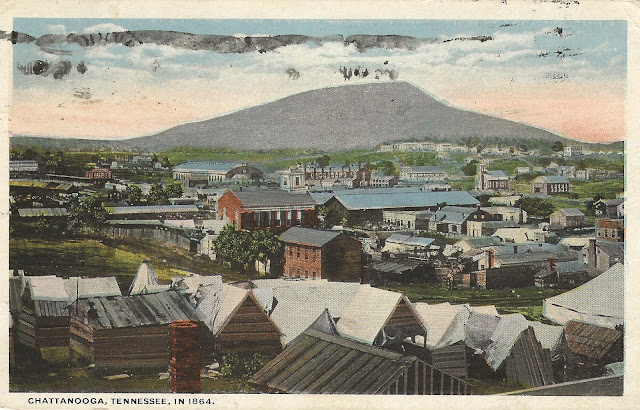Marching into Chattanooga with the 97th Ohio
For more than a year, the Army of the Cumberland had sought to capture the strategic city of Chattanooga, Tennessee. Nestled into a bend of the Tennessee River and dominated by the towering heights of Lookout Mountain to the west, Chattanooga was the major railroad junction and primary supply depot for Braxton Bragg's Army of Tennessee. The key to the Confederate heartland lay through Chattanooga and by early September that key was about to slide into the Union's pocket.
General Thomas L. Crittenden's 21st Army Corps had been demonstrating against Chattanooga since late August, a feint designed to keep Braxton Bragg's attention away from the Tennessee River crossings further downstream where General William S. Rosecrans intended to move the 14th Corps and 20th Corps of his army across the river, aiming to fall on Bragg's rear and force his departure from Chattanooga. The ploy worked, and on September 9th the Confederates evacuated the city. Lieutenant Colonel Milton Barnes' 97th Ohio was among the first Federal troops to march into the city as Colonel Barnes relates in the article below.
Wagner’s Brigade, of which the 97th Ohio was a part, crossed the Cumberland Mountains direct from Pelham approaching Chattanooga from the north. Several days were spent about the hills north of the river, fronting the city, skirmishing with Rebel pickets and exchanging shot and shell with the enemy. They occupied a strong fort on a beach on the east side of Cameron Hill about 400 feet high immediately overlooking the river inside the city limits. We had pushed their pickets back across the river and our picket line finally extended along the north bank of the river immediately opposite the city.
On the 8th
day of September 1863, the 97th Ohio was on picket duty and occupied
that line skirmishing with the enemy across the river all day. The next morning
(September 9th) as soon as it was light enough to see, it was discovered
that the heavy guns in this fort had been removed, although the pickets were
still there and resumed their firing. It soon became evident that the Rebels
were evacuating the city and about 8 a.m. their officer of the day rode down
the line and took off his pickets. A citizen then waved his white handkerchief
to us. Two line officers of the 97th Ohio were immediately
dispatched in a dugout to cross over and bring back the old mule ferry boat
that lay at the wharf at the foot of Market Street. Taking two companies of the
97th with the colors, Major Moore and myself with our horses boarded
the ferryboat, crossed over quickly, deployed as skirmishers, and climbed the
steep declivity into this fort, took possession of it, and immediately planted
the colors of the 97th Ohio on its parapet.
 |
| Lt. Col. Milton Barnes 97th O.V.I. |
At the sight of
the flag as it floated from this fort from which we had been vigorously shelled
for several days, the whole brigade on the hill north of the river sent up a shout,
while Cox’s battery fired a salute of six guns. On reaching this fort (which
has since been converted into a reservoir for the city waterworks), a fine view
was spread out before us of the city and its surroundings including the old
Crutchfield House which was but a few blocks away. The rear of the retreating
column of the Rebel army was still visible in the lower part of the city, but
the Stars and Stripes had not yet made their appearance on the Crutchfield
House or surely someone of the 70 or 80 soldiers then in the fort and in full
view would have noticed it. In this connection, an important fact will be
remembered by those who had reached the fort and run up the 97th
Ohio’s flag, that is that skirmishing was distinctly heard at the foot of Lookout
Mountain. This firing, however, ceased pretty soon and it was not long until
there was a demonstration of Union troops coming in from that direction. It was
recognition of the fact that Wagner’s brigade was the first in the city that
they were placed on provost duty and General Wagner was made commandant of the
post and we held in reserve, not called into action at the Battle of Chickamauga.
Sources:
“Taking of Chattanooga,” Lieutenant Colonel Milton Barnes, National
Tribune, April 15, 1886, pg. 4












Comments
Post a Comment